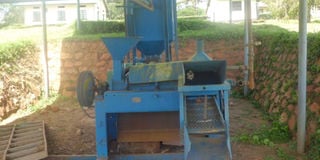Prime
Pulping machine processes and tests coffee

The pulping machine, which is used for wet processing of coffee and testing quality of the berries. Photo by Lominda Afedraru.
Coffee farmers who dry their coffee by spreading them on the ground in the sunshine can adopt the wet coffee processing method using the coffee pulping machine, which they can either purchase as a group or individually.
The pulping machines comprises different sizes and capacities. The ones, which are affordable to small-scale farmers have processing capacity of 15 to 400 kg per hour but there are those, which have a processing capacity of 1,000 to 4,000 kg per hour or more.
Sensitise farmers
Mr Patrick Kucel, a plant entomologist at the Coffee Research Institute (Corec) in Kituuza, Mukono, in explaining how the machine operates, said the institute has one with a bigger processing capacity for purposes of sensitising visiting farmers.
It uses a diesel generator and, apart from it being for sensitisation, they also use it for sampling coffee berries from the different species to establish the quality.
“The machine operates in such a way that once the wet coffee berries are picked from the farm, it is first washed before it is poured through the funnel, which is the first outlet in the machine. Water is also poured in through this outlet to washing the berries when the pulping process starts,” Kucel said.
Once the machine begins running, it draws the water in the revolving drum and when the engine is running at full capacity, the drum rubs against the surface and removes the pulp of the berry.
The operation
Other functions involve the use of the disc and large fruit tanks. The wet parchment is discharged into fermentation and washing tanks while the coffee berry skin is discharged into a pit for water recovery and recirculation.
The pulping operation takes place between the rubbing action of the bulbs on the disc and the lateral pulping bars called chop rails.
The gap between the surface of the bulb and the chop rail can be adjusted to allow any clearance that may be required according to the variety and size of coffee berry being processed. The part called hopper is fitted with a feed mechanism, which ensures even feeding of the berries to the disc surface.
Once this is done, the clean berry is removed from outgoing outlet in a container and the farmer can then spread it to dry after fermentation.
The other parts include a drum pulper, which contains central roller with crescent-shaped projection all over the drum, and a rotating hand-wheel linked with this roller operates the drum.
Adjust to berry size
The central chamber comprises breast assembly that can be slightly moved inward and outward to adjust according to the size of the berries, which are being fed via the inlet hopper. The berries are uniformly passed by the inner chamber with the aid of a feed roller to ensure that the skin of the berries separates smoothly and it moves in the inner chamber, and later is squeezed between the central drum and the breast part.
The proprietor of Volcano Coffee, which deals in coffee processing and trading, Mr Gerald Katabazi, said the processors load the coffee berries into the pulping machine in different sizes depending on the size of the machine.
The coffee pulping machine can be purchased in the agro-input shops in urban areas or from dealers who import them into the country.




